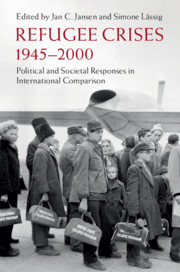Book contents
- Refugee Crises, 1945–2000
- Publications of the German Historical Institute
- Refugee Crises, 1945–2000
- Copyright page
- Contents
- Contributors
- Acknowledgments
- 1 Responses to Refugee Crises in International Comparison
- Part I The Postwar and Decolonization Moment
- 2 The Dynamics of Expellee Integration in Post-1945 Europe
- 3 Integrating without a Host Society
- 4 Pakistan
- 5 Transgenerational Displacement and Integration among Palestinians and Palestinian Refugees from Syria in Jordan
- 6 A Matter of Definition
- Part II Refugee Movements during the Cold War and beyond
- Part III Afterword
- Index
3 - Integrating without a Host Society
The Repopulation of Poland’s Western Territories after 1945
from Part I - The Postwar and Decolonization Moment
Published online by Cambridge University Press: 13 October 2023
- Refugee Crises, 1945–2000
- Publications of the German Historical Institute
- Refugee Crises, 1945–2000
- Copyright page
- Contents
- Contributors
- Acknowledgments
- 1 Responses to Refugee Crises in International Comparison
- Part I The Postwar and Decolonization Moment
- 2 The Dynamics of Expellee Integration in Post-1945 Europe
- 3 Integrating without a Host Society
- 4 Pakistan
- 5 Transgenerational Displacement and Integration among Palestinians and Palestinian Refugees from Syria in Jordan
- 6 A Matter of Definition
- Part II Refugee Movements during the Cold War and beyond
- Part III Afterword
- Index
Summary
Wartime destruction and postwar redrawing of borders sparked a refugee crisis in Poland massive in dimensions and very particular in character. Two million ethnic Poles, driven out of the territories annexed by the Soviet Union at the end of the war, had to find new homes in the German territory ceded to Poland in 1945. The refugees did not encounter a “host society” per se, as the region’s former ethnic German population had been expelled, nor did they settle entirely unpopulated land. Some 2.5 million other Poles had migrated from the war-torn towns and villages of central Poland to the country’s new west shortly before the refugees’ arrival. These groups of Poles were joined by 200,000 Polish Jews who had survived the Holocaust, 200,000 Ukrainian-speakers forcibly resettled from southern and eastern Poland in 1947, and 1,000,000 so-called autochthones in Upper Silesia and Masuria, former German citizens allowed to stay in Poland because of their presumed Polish background. This essay explores strategies used to integrate this diverse population and the long-term consequences of forced migration.
- Type
- Chapter
- Information
- Refugee Crises, 1945-2000Political and Societal Responses in International Comparison, pp. 55 - 82Publisher: Cambridge University PressPrint publication year: 2020



